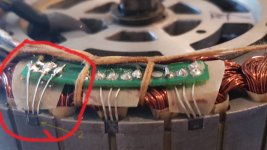Warekiwi said:
I've checked all the wiring and as far as I can see there was only ONE failure there (the wire from a Hall sensor to the Grinfineon) It seems weird that that caused the cascade of events effectively destroying a Hall sensor, a Mosfet AND the CA3!
Based on my own experience, the only type of fault that would destroy the CA3 and the hall sensor and potentially a FET at the same time would be a direct short between the hall sensor wire that is used as the speed sensor for the CA3, and a high voltage source like a phase wire or a battery wire.
In my case it was the battery wire, at an external Grin shunt. In your case, it's much more likely to be in the motor-to-controller cable, almost always at the axle, typically just at the axle exit but could be anywhere from inside the motor to that point. Can also be anywhere along the cable. The problem could be intermittent or it could be continuous.
If you can't see a problem, it doesn't mean it isn't still there--a tiny break in hte insulation where wires press together is all it takes, and when you pull the wires apart from each other such breaks can "heal" enough to be invisible without sufficient magnification and light.

(and a continuity test will not show a problem at that point either).
If the circuits inside the CA lasted long enough before failing, or failed in a permanent short to ground or battery positive, they could have blown the FETs on the phase that is connected to the phase wire. Or there could be more than just the one phase and hall wire that's shorted inside the cable.
You can prevent such a failure from being possible by using an external speed sensor on the wheel, disconnecting the CA3's wire that goes to the hall sensor and connecting it to the external sensor. Normally I'd recommend opening the CA3 and soldering in a sensor (either from an old bike computer, or from Grin), but it might be easier for you if you use the CA3-DPS version from Grin instead of just the CA3-DP, so it already has the work done for you.
Then the CA3 is not connected to the hall sensors at all, so no matter what happens between motor and controller, the CA3 is isolated from them completely. Even if the motor and controller catch fire :lol: then the CA3 is unaffected unless that end of the bike burns too.

Since your CA3 wasn't fried completley like mine was, then your failure may not have been the same cause, but if you wish to ensure it can't happen in the future, the above would do that.
There are still other failures that can occur from wiring shorts, but direct high voltage into the CA3's speed sensor line isn't one of them at that point.




